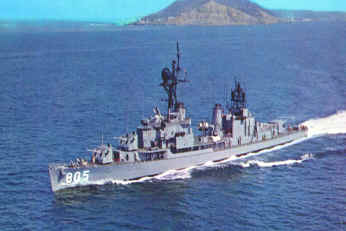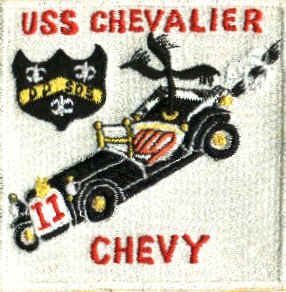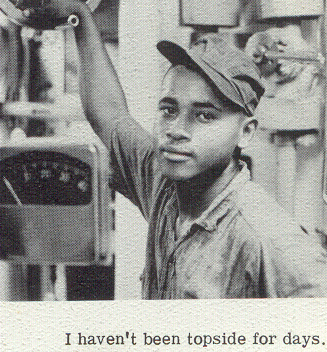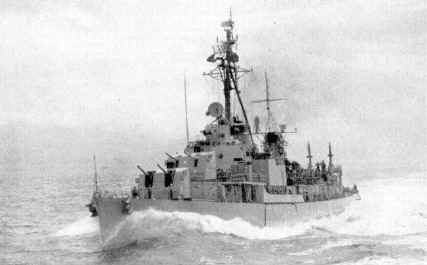Note: There are a lot of acronyms in this story......they are all
discussed in detail at the end under "Definitions"!

THE OIL KING
By Richard H. King, CDR USNR-Ret.
At the time of this story, CDR King was LT JG, Main Propulsion
Assistant (1965-1968),
(Assistant Engineering Officer for Main Propulsion)
U.S.S. CHEVALIER (DD-805)
The FRAM destroyer was
essentially one of many versions of late WWII destroyers that were
"life extended" by virtue of a program called FRAM (Fleet Rehabilitation
and Modernization Program). Some of the FRAM'd Destroyers eventually ended
up with twenty five years service in our Navy and thirty more years in a smaller Navy (South Korea, Taiwan and South America, plus Greece and
Turkey). The FRAM program began in the late fifties and was ended in
the early sixties. The common thread, good and bad, was that these destroyers
were mechanically reliable.
years in a smaller Navy (South Korea, Taiwan and South America, plus Greece and
Turkey). The FRAM program began in the late fifties and was ended in
the early sixties. The common thread, good and bad, was that these destroyers
were mechanically reliable.
They were also labor
intensive; everything in the engineering plant was manually operated
including the water level of the steam drums in the boilers. It took about
20 engineers around the clock per watch to man one of these things as they
needed to operate at a steady 600 PSI. The 1200 "pounders" (lbs per sq. inch operating pressure) came later and had
some design problems. The main, turbo and auxiliary steam lines on a FRAM
Destroyer had bolted flanges which ship's repair force could repair or at least
do a "ship to shop and back" repair (by
removing the bad piece, carrying it to a shop, picking up the new piece a few
days later and re-installing) . The 1200 pounders had all welded
steam connections and only a highly certified welder could work on them
followed by extensive x-ray and similar tests requiring expensive test equipment
carried only by some tenders. That is why ship's force generally could not do
their own steam line repairs on Post FRAM Ships.
And although they were supposed to need less
engineers per watch than FRAM DESTROYERS, that goal was never achieved. They had the
same number of boiler technicians (BTs) on watch per boiler, except they became tired, bored and
sleepier quicker when the automated system was actually working and when the
"s" "h" "t" "f" they did not have the
options FRAM BT's had. And when there were problems, problems a FRAM
crew could fix with ship's force, only a shipyard could fix a 1200 pounder. So
what did we gain? Hardly nothing. Back to the drawing board. Hence
the gas turbine Spruance Class.
Enter the OIL KING !
The "Oil King" was the boiler
technician (BT) in charge of the some 200,000 gallons of black oil (NSFO) we carried in about twenty different tanks,
including four "ready service" tanks (two forward and two aft) and three amidships tanks that we
rarely tapped.
The OIL KING had watch stander's liberty both underway and in port and an open
gangway under most circumstances. According to some "BUPERS" (Bureau
of Personnel) manning document, on a FRAM it was supposed to be an E-7 position
during wartime, E-6 during peacetime. He had his own little shack with
laboratory equipment and had to test feed water quality and fuel oil quality on
a regular basis (several times a day on feed water). We had two fuel oil
transfer pumps which he or his assistant used every few hours to move oil around
from storage tanks to the service tanks to keep the ship on an even keel.
gallons of black oil (NSFO) we carried in about twenty different tanks,
including four "ready service" tanks (two forward and two aft) and three amidships tanks that we
rarely tapped.
The OIL KING had watch stander's liberty both underway and in port and an open
gangway under most circumstances. According to some "BUPERS" (Bureau
of Personnel) manning document, on a FRAM it was supposed to be an E-7 position
during wartime, E-6 during peacetime. He had his own little shack with
laboratory equipment and had to test feed water quality and fuel oil quality on
a regular basis (several times a day on feed water). We had two fuel oil
transfer pumps which he or his assistant used every few hours to move oil around
from storage tanks to the service tanks to keep the ship on an even keel.
I have a vivid picture in my mind of the Oil King sitting
at the Chief Engineer's Desk in the Chief Engineer's stateroom studying the tank
tables and charts (the
stateroom designated for the Chief Engineer was slightly to port of the after
service tanks and that was where their sounding tubes were located, or just
outside the door). Good thinking on the part of someone at BUPERS because
if an officer's stateroom had to be invaded day and night every few hours by
someone, it best be the Chief Engineer who best understood why. Either the Oil
king or his assistant would be in and out of there throughout the night taking
soundings with a flashlight.
When we refueled (whether at sea or in port) he took
command of a sound powered phone circuit that led to each of the twenty tanks.
With diagrams and papers in front of him, he would direct other
BT's when to shut key valves and eventually when to call for cease pumping.
It was LT Al Sherman's and BT2 Richard Morton's opinion that the best rank for
the job on a FRAM was a senior E-5. Chiefs were too lazy to do it right
and First Class were better used as being in charge of a fire room. But he
had to be the best and brightest BT2, smart as a whip and stable as a rock. Even
as early as the late sixties, an oil spill off Shelter Island Yacht Club in San
Diego Harbor could ruin a lot of officer's day including the Captain's.
The Oil King had direct access to
the Captain, Chief Engineer and of course the junior officer and Chief in the
chain of command. He would fill out a small form every morning
about our fuel state, with input from the Water King (a Machinist Mate) as to water volume
but which included the results of his laboratory tests as to water quality and
under our system he was supposed  to
route a copy to the Chief Engineer, MPA, Chief BTC and Chief MMC before lunch.
The original copy went to the Captain as part of the "noon report".
We were blessed with some good ones on "Chevy" during my watch,
but the best of the greatest was in my humble opinion, BT2
Nathaniel Thomas from Virginia. to
route a copy to the Chief Engineer, MPA, Chief BTC and Chief MMC before lunch.
The original copy went to the Captain as part of the "noon report".
We were blessed with some good ones on "Chevy" during my watch,
but the best of the greatest was in my humble opinion, BT2
Nathaniel Thomas from Virginia.
The picture at left was taken before he became "Oil
King", he was then "top watch" and maintenance chief in the
forward fireroom. At the time, he was the only Black (of any rank) in
"B" Division and was highly respected. He really caught my attention
when I realizes he was doing 90% of the paperwork for both firerooms (MDC/PMS).
We also had an interesting unannounced "FLAG
VISIT" in the forward fireroom when he was steaming a boiler, in charge.
I had twenty seconds to tell him (by phone) a four star was going to be climbing
down the ladder to his boiler flat. The Admiral challenged the
"perfection" we had down there and really grilled Petty Officer
Thomas. Thomas was great, he said "we work hard and long" but
once you build a near perfect plant, it is easy to keep it that way. WOW,
I was impressed, as was the four star Admiral. The
Admiral grilled Thomas, the Captain stood behind the Admiral and I stood
behind the Captain waiting for disaster to strike. Nathaniel Thomas argued
with the Admiral and won his case. I know the Admiral was impressed. If
I recall directly, the Admiral was Vice Chief of Naval Operations Admiral
Revero. I was shaking. Petty Officer Thomas remained calm and
collected. He stood his ground and defended his boiler flat
that he was in charge of.

Now for some definitions:
-
BTC stands for "Boiler Technician Chief"
(E-7) in olden days "Boiler Tender Chief".
-
MM stands for "Machinist Mate", the rate
that handled the steam turbines, turbo generators, evaporators, condensers,
etc.
-
In simplistic terms, the "BT's" made the steam and the
"MM's" put that steam to work and sent the condensate back to the
BT's to make more steam. It was called the
"steam cycle" because in theory you used the same water over and
over and over again.
-
"MPA" stood for "Main Propulsion
Assistant" which I describe to civilians (easier to understand) as
"Assistant Engineering Officer for Main Propulsion". Or on a
merchant steamship, "First Engineer" (after the Chief
Engineer).
-
"MMC" stood for "Machinist Mate
Chief (E-7). Actually, we (on the USS Chevalier) had a "SPCM" (E-9). "Steam Propulsion Chief Master".
Same as Sergeant Major in the Army or Marine Corps. The idea was that
upon moving from the rate of E-8 to E-9 you were suddenly an expert in both
of two closely related rates. And that was fairly much true, but it is
my understanding that we went back to the way things were in the olden days
and the rate of SPCM has been abolished.
"SPCM" (E-9). "Steam Propulsion Chief Master".
Same as Sergeant Major in the Army or Marine Corps. The idea was that
upon moving from the rate of E-8 to E-9 you were suddenly an expert in both
of two closely related rates. And that was fairly much true, but it is
my understanding that we went back to the way things were in the olden days
and the rate of SPCM has been abolished.
-
The E-9 rates are now MMCM (Master Chief
Machinist Mate - E-9) or BTCM (Master Chief Boilerman
- E-9).
-
MDC and PMS. In the days before you had a
computer, the Navy was trying to use mainframe computers to sort out a lot
of information concerning the maintenance of Naval ships.
"MDC" stood for "Maintenance Data Collection".
"PMS" stood for "Planned Maintenance
System". There were a bunch of forms, which were very
complicated, that sailors had to fill out, and everything was done in code. There
was a thick book that came with the system where you found your problem and
looked in the book and found the right code.
I remember one interesting case involving a
"chair". What, a chair? Yes, a chair, in the
engineering log room. It was an aluminum chair and the seat of the
chair was broke. We were under a moratorium for buying new office
furniture. I figured if the tender (a ship used to supply destroyer's
with parts and supplies) would cut me a piece of plywood to screw onto the
chair, perhaps with some padding and some sort of vinyl covering, I could
re-cycle that chair for another ten years.
So I tried to fill out a "4700-2C" form for the
tender carpentry shop to make me a new "seat" for a chair.
All I was asking was for the tender carpentry shop to cut a piece of
plywood, apply some padding and stretch some sort of naugahyde over it.
The problem that developed was that there was no "code
number" in the MDC system for a chair. I took that case as
a challenge and spent weeks at it. My chair was eventually fixed, but
the amount of paperwork it took outweighed the chair. The system
was not user friendly. For example, if a bearing wiped on a pump
shaft, the sailor who fixed it had to fill out a 4700-2B (repair completed).
 If
something was broke, but we didn't have the needed part, he was supposed to
fill out a 4700-2D (repair deferred). If the ship wanted either a
shipyard, SRF or Tender to tackle the job, a 4700-2C was filled out. This
was an early attempt by the Navy to use computers to replace the memory of
the senior petty officers and officers actually on board as to what
was done to what machinery when and what we need do to soon. We
had no computers on board. But about six months after all these little
forms had been sent in, we would receive a fifty pound box of paper of
computer print out (perforated at the edges) telling us what we did and what
we needed. Nobody ever ploughed through those reams and reams of
material because by the time it got back to the ship, it was
ancient history and by that time we had new problems. Things may
have got better later, I will let our younger members address that. If
something was broke, but we didn't have the needed part, he was supposed to
fill out a 4700-2D (repair deferred). If the ship wanted either a
shipyard, SRF or Tender to tackle the job, a 4700-2C was filled out. This
was an early attempt by the Navy to use computers to replace the memory of
the senior petty officers and officers actually on board as to what
was done to what machinery when and what we need do to soon. We
had no computers on board. But about six months after all these little
forms had been sent in, we would receive a fifty pound box of paper of
computer print out (perforated at the edges) telling us what we did and what
we needed. Nobody ever ploughed through those reams and reams of
material because by the time it got back to the ship, it was
ancient history and by that time we had new problems. Things may
have got better later, I will let our younger members address that.

Comments on the Navy's "Planned Maintenance
System" (PMS)
I think it was
around the time our reserve crew was on McKean that I was introduced to PMS.
"What are we doing this weekend?" "Were doing PMS on the
condensate pumps". I still believe in the theory of if it ain't
broken don't fix it, but Oh No, we had to unbolt the deck plates on the lower
level and disassemble a perfectly good condensate pump while standing in
the bilges. The shaft and impeller were removed and micrometer readings
taken of the wearing rings and other dimensions. Then it had to be put
together again and you didn't just run down to Manny, Mo, & Jacks Condensate
pump supply house either for parts. All the gaskets had to be made by hand
using a ball peen hammer on the edges and a gasket cutter for the holes.
If we were lucky Engineering Supply had some bearings left over from WWII, but
most of the time nothing was wrong with the pump. Robert TeGroen

 

|
